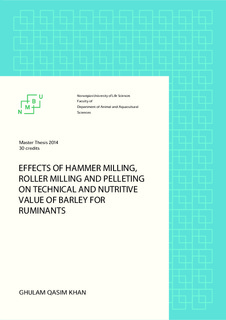| dc.contributor.author | Khan, Ghulam Qasim | |
| dc.date.accessioned | 2014-09-24T11:26:55Z | |
| dc.date.available | 2014-09-24T11:26:55Z | |
| dc.date.copyright | 2014 | |
| dc.date.issued | 2014-09-24 | |
| dc.identifier.uri | http://hdl.handle.net/11250/221435 | |
| dc.description | To evaluate the effects of processing of barley on particle size distribution and pellet quality along with digestibility of different nutrients and milk production in ruminants. | nb_NO |
| dc.description.abstract | Barley is world’s fourth grain with respect to its production. To understand its characteristics and effects of different processing methods upon its utilization by ruminants, a comprehensive literature review was conducted which was followed by own study. The own study was initiated and financed by Felleskjøpet Fôrutvikling (Trondheim, Norway) and consists of two parts. In the first part, experimental feeds (pure barley) were produced at Center of Feed Technology (Fôrtek), NMBU to study the effects of processing on particle size distribution and pellet quality along with energy consumption. In the second part, selected feeds were fed to animals in metabolism unit of Department of Animal and Aquacultural Sciences (IHA), NMBU to evaluate effects of processing on digestibility and production. Total 12 feeds were produced; three were hammer milled (HM) by using screen size 2mm, 4mm, 6mm and three were roller milled (RM) with the gap distance between the rolls 0.25mm, 0.75mm, 1.5mm. All the six feeds were then pelleted with 75ºC conditioning temperature. Hammer mill resulted in lower mean particle sizes than roller mill. Roller mill yielded uniform particle size distribution than hammer mill however hammer mill gave more durable pellet with less energy consumption. Three feeds HM 2mm (mash), RM 1.5mm (mash) and RM 1.5mm (pelleted) were selected and fed to animals along with a protein concentrate (FORMEL 140) and silage. Chemical composition of three barley feeds were not significantly (P>0.05) affected by the treatments. Likewise, feed (silage) intake, and ruminal and total tract digestibility of dry matter, starch, protein, fat, and ash were not significantly different among treatments (P>0.05). Total tract digestibility of neutral detergent fiber (NDF) was significantly higher (P<0.05) for HM 2mm (mash) feed. Numerically, total tract digestibility of protein was higher for RM 1.5mm (mash) diet whereas digestibility of starch was higher for HM 2mm (mash) diet. With the exception of protein and urea concentration in milk, no significance (P>0.05) effects of any treatment was found on milk production. RM 1.5mm (pelleted) feed significantly (P<0.05) increase the concentration of protein and decrease the concentration of urea in milk. Yield of milk was numerically higher for RM 1.5mm (mash) feed. | nb_NO |
| dc.description.sponsorship | Felleskjøpet Fôrutvikling (Trondheim, Norway) | nb_NO |
| dc.language.iso | eng | nb_NO |
| dc.publisher | Norwegian University of Life Sciences, Ås | |
| dc.subject | VDP::Teknologi: 500, Barley, Ruminants, Hammer milling, Roller milling, Pelleting, Digestibility, Milk production | nb_NO |
| dc.title | Effect of hammer milling, roller milling and pelleting on technical and nutritive value of barley for ruminants | nb_NO |
| dc.type | Master thesis | nb_NO |
| dc.subject.nsi | VDP::Agriculture and fishery disciplines: 900::Agriculture disciplines: 910::Animal feeding: 918 | nb_NO |
| dc.source.pagenumber | 39 | nb_NO |
| dc.description.localcode | M-HF | nb_NO |
